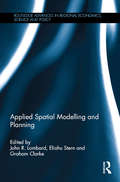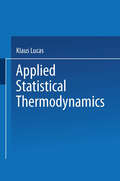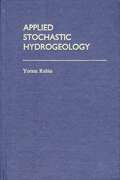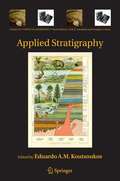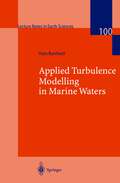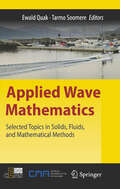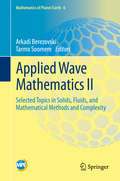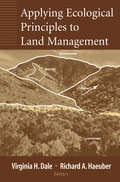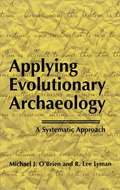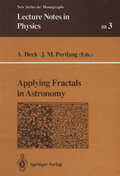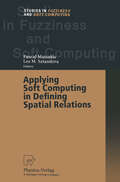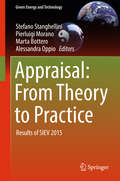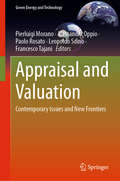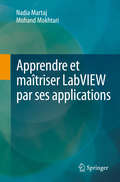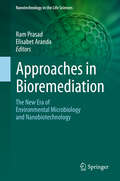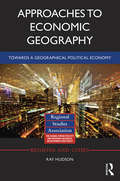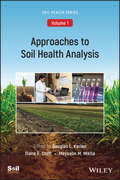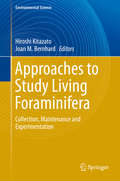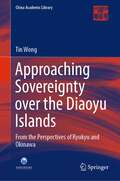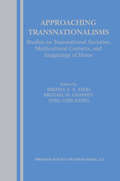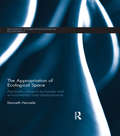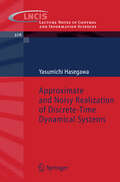- Table View
- List View
Applied Spatial Modelling and Planning (Routledge Advances in Regional Economics, Science and Policy)
by John R. Lombard Eliahu Stern Graham ClarkeThis book highlights the extraordinary range of areas to which geographical analysis and spatial modelling can bring lessons and insights. It shows how these techniques have been used to address ‘real world’ issues that are of concern to international organisations, public agencies and businesses, as illustrated by actual funded projects that geographers have developed collaboratively with end-users. Applied Spatial Modelling and Planning shows how much geographical research is policy relevant to a wide variety of agencies through the use of GIS and spatial modelling in applied geography. The book’s chapters contain a cross-section of innovative applications and approaches to problem solving within five major domains of the dynamics of economic space, housing and settlements, population movements and population ageing, health care, and the environment. Using a number of case studies on the use of GIS and spatial modelling, this book demonstrates the fact that much of what is done by quantitative geographers is not only relevant within academia, but also has use in policy work. This book will appeal to an international audience interested in cutting-edge spatial modelling to better understand the processes involved in solving real problems.
Applied Statistical Thermodynamics
by Klaus LucasThe book guides the reader from the foundations of statisti- cal thermodynamics including the theory of intermolecular forces to modern computer-aided applications in chemical en- gineering and physical chemistry. The approach is new. The foundations of quantum and statistical mechanics are presen- ted in a simple way and their applications to the prediction of fluid phase behavior of real systems are demonstrated. A particular effort is made to introduce the reader to expli- cit formulations of intermolecular interaction models and to show how these models influence the properties of fluid sy- stems. The established methods of statistical mechanics - computer simulation, perturbation theory, and numerical in- tegration - are discussed in a style appropriate for newcom- ers and are extensively applied. Numerous worked examples illustrate how practical calculations should be carried out.
Applied Stochastic Hydrogeology
by Yoram RubinStochastic Subsurface Hydrogeology is the study of subsurface, geological heterogeneity, and its effects on flow and transport process, using probabilistic and geostatistical concepts. This book presents a rational, systematic approach for analyzing and modeling subsurface heterogeneity, and for modeling flow and transport in the subsurface, and for prediction and decision-making under uncertainty. The book covers the fundamentals and practical aspects of geostatistics and stochastic hydrogeology, coupling theoretical and practical aspects, with examples, case studies and guidelines for applications, and provides a summary and review of the major developments in these areas.
Applied Stratigraphy (Topics in Geobiology #23)
by Eduardo A. M. KoutsoukosStratigraphy has come to be indispensable to nearly all branches of the earth sciences, assisting such endeavors as charting the course of evolution, understanding ancient ecosystems, and furnishing data pivotal to finding strategic mineral resources. This book focuses on traditional and innovative stratigraphy techniques and how these can be used to reconstruct the geological history of sedimentary basins and in solving manifold geological problems and phenomena.
Applied Turbulence Modelling in Marine Waters (Lecture Notes in Earth Sciences #100)
by Hans BurchardThe simulation of turbulent mixing processes in marine waters is one of the most pressing tasks in oceanography. It is rendered difficult by the various complex phenomena occurring in these waters like strong stratification, ex ternal and internal waves, wind generated turbulence, Langmuir circulation etc. The need for simulation methods is especially great in this area because the physical processes cannot be investigated in the laboratory. Tradition ally, empirical bulk type models were used in oceanography, which, however, cannot account for many of the complex physical phenomena occurring. In engineering, statistical turbulence models describing locally the turbulence mixing processes were introduced in the early seventies, such as the k E model which is still one of the most widely used models in Computational Fluid Dy namics. Soon after, turbulence models were applied more and more also in the atmospheric sciences, and here the k kL model of Mellor and Yamada became particularly popular. In oceanography, statistical turbulence mod els were introduced rather late, i. e. in the eighties, and mainly models were taken over from the fields mentioned above, with some adjustments to the problems occurring in marine waters. In the literature on turbulence model applications to oceanography problems controversial findings and claims are reported about the various models, creating also an uncertainty on how well the models work in marine water problems.
Applied Wave Mathematics: Selected Topics in Solids, Fluids, and Mathematical Methods
by Ewald Quak Tarmo SoomereThis edited volume consists of twelve contributions related to the EU Marie Curie Transfer of Knowledge Project Cooperation of Estonian and Norwegian Scienti c Centres within Mathematics and its Applications, CENS-CMA (2005-2009), - der contract MTKD-CT-2004-013909, which ?nanced exchange visits to and from CENS, the Centre for Nonlinear Studies at the Institute of Cybernetics of Tallinn University of Technology in Estonia. Seven contributions describe research highlights of CENS members, two the work of members of CMA, the Centre of Mathematics for Applications,Univ- sity of Oslo, Norway, as the partner institution of CENS in the Marie Curie project, and three the ?eld of work of foreign research fellows, who visited CENS as part of theproject. Thestructureofthebookre?ectsthedistributionofthetopicsaddressed: Part I Waves in Solids Part II Mesoscopic Theory Part III Exploiting the Dissipation Inequality Part IV Waves in Fluids Part V Mathematical Methods The papers are written in a tutorial style, intended for non-specialist researchers and students, where the authors communicate their own experiences in tackling a problem that is currently of interest in the scienti?c community. The goal was to produce a book, which highlights the importance of applied mathematics and which can be used for educational purposes, such as material for a course or a seminar. To ensure the scienti?c quality of the contributions, each paper was carefully - viewed by two international experts. Special thanks go to all authors and referees, without whom making this book would not have been possible.
Applied Wave Mathematics II: Selected Topics in Solids, Fluids, and Mathematical Methods and Complexity (Mathematics of Planet Earth #6)
This book gathers contributions on various aspects of the theory and applications of linear and nonlinear waves and associated phenomena, as well as approaches developed in a global partnership of researchers with the national Centre of Excellence in Nonlinear Studies (CENS) at the Department of Cybernetics of Tallinn University of Technology in Estonia.The papers chiefly focus on the role of mathematics in the analysis of wave phenomena. They highlight the complexity of related topics concerning wave generation, propagation, transformation and impact in solids, gases, fluids and human tissues, while also sharing insights into selected mathematical methods for the analytical and numerical treatment of complex phenomena. In addition, the contributions derive advanced mathematical models, share innovative ideas on computing, and present novel applications for a number of research fields where both linear and nonlinear wave problems play an important role.The papers are written in a tutorial style, intended for non-specialist researchers and students. The authors first describe the basics of a problem that is currently of interest in the scientific community, discuss the state of the art in related research, and then share their own experiences in tackling the problem.Each chapter highlights the importance of applied mathematics for central issues in the study of waves and associated complex phenomena in different media. The topics range from basic principles of wave mechanics up to the mathematics of Planet Earth in the broadest sense, including contemporary challenges in the mathematics of society. In turn, the areas of application range from classic ocean wave mathematics to material science, and to human nerves and tissues. All contributions describe the approaches in a straightforward manner, making them ideal material for educational purposes, e.g. for courses, master class lectures, or seminar presentations.
Applying Ecological Principles to Land Management
by Virginia H. Dale R. T. T. Forman Richard A. HaeuberThis volume incorporates case studies that explore past and current land use decisions on both public and private lands, and includes practical approaches and tools for land use decision-making. The most important feature of the book is the linking of ecological theory and principle with applied land use decision-making. The theoretical and empirical are joined through concrete case studies of actual land use decision-making processes.
Applying Evolutionary Archaeology: A Systematic Approach
by Michael J. O'Brien R. Lee LymanAnthropology, and by extension archaeology, has had a long-standing interest in evolution in one or several of its various guises. Pick up any lengthy treatise on humankind written in the last quarter of the nineteenth century and the chances are good that the word evolution will appear somewhere in the text. If for some reason the word itself is absent, the odds are excellent that at least the concept of change over time will have a central role in the discussion. After one of the preeminent (and often vilified) social scientists of the nineteenth century, Herbert Spencer, popularized the term in the 1850s, evolution became more or less a household word, usually being used synonymously with change, albeit change over extended periods of time. Later, through the writings of Edward Burnett Tylor, Lewis Henry Morgan, and others, the notion of evolution as it applies to stages of social and political development assumed a prominent position in anthropological disc- sions. To those with only a passing knowledge of American anthropology, it often appears that evolutionism in the early twentieth century went into a decline at the hands of Franz Boas and those of similar outlook, often termed particularists. However, it was not evolutionism that was under attack but rather comparativism— an approach that used the ethnographic present as a key to understanding how and why past peoples lived the way they did (Boas 1896).
Applying Fractals in Astronomy (Lecture Notes in Physics Monographs #3)
by Andre Heck Jean M. Perdang'Fractal geometry addressesitselfto questions that many people have been asking themselves. It con cerns an aspect of Nature that almost everybody had been conscious of, but could not address in a formal fashion. ' 'Fractal geometry seems to be the proper language to describe the complezity of many very compli cated shapes around us. ' (Mandelbrot, 1990a) 'I believe that fractals respond to a profound un easiness in man. ' (Mandelbrot, 1990b) The catchword fractal, ever since it was coined by Mandelbrot (1975) to refer to a class of abstract mathematical objects that were already known at the turn ofthe 19th century, has found an unprecedented resonance both inside and outside the scientific community. Fractal concepts, far more than the concepts of catastrophe theory introduced a few years earlier, are currently being applied not only in the physical sciences, but also in biology and medicine (Goldberger and West 1987). In the mid-eighties, Kadanoff (1986) asked the question: 'Why all the fuss about /ractals'! '. He offered a twofold answer: in the first place, it is 'because of the practical, technological importance of fractal objects'. Indeed he emphasised the relevance of these structures for materials scientists and oil drilling engineers, in search of structures with novel properties, or models for the flow of oil through the soil. His second answer was: 'Because of the intellectual interest of fractals '.
Applying Soft Computing in Defining Spatial Relations (Studies in Fuzziness and Soft Computing #106)
by Pascal Matsakis Les M. SztanderaGeometric properties and relations play central roles in the description and processing of spatial data. The properties and relations studied by mathematicians usually have precise definitions, but verbal descriptions often involve imprecisely defined concepts such as elongatedness or proximity. The methods used in soft computing provide a framework for formulating and manipulating such concepts. This volume contains eight papers on the soft definition and manipulation of spatial relations and gives a comprehensive summary on the subject.
Appraisal: Results of SIEV 2015 (Green Energy and Technology)
by Stefano Stanghellini Pierluigi Morano Marta Bottero Alessandra OppioThis book documents the state of the art and the emerging operational perspectives in the field of the appraisal discipline. It covers a wide range of topics, including energy efficiency, environmental sustainability, socio-economic evaluation of regional and urban transformations, real estate and facility management, risk management. It also discusses the potential role of appraisal in minimising unexpected consequences; the role of evaluators in urban development projects as well as the contribution of several methodologies with respect to the overall planning and design processes; the need to manage the complexity of the current decision contexts, while at the same time promoting efficient and effective evaluation processes; improving the quality of discussion and communication of the outcomes of evaluation processes; as well as the appropriateness of current regulation and policy regimes (EU, national, regional etc.). It comprises a selection of the best papers presented at the SIEV 2015 conference "Appraisal: Current Issues and Problems", which was held in Bari, Italy, in July 2015, and brought together architects, engineers, urban planners, decision-makers and government representatives.
Appraisal and Valuation: Contemporary Issues and New Frontiers (Green Energy and Technology)
by Pierluigi Morano Alessandra Oppio Paolo Rosato Leopoldo Sdino Francesco TajaniThis book features a selection of the best papers presented at two recent conferences organized by the SIEV (Italian Society of Appraisal and Valuation). Taking into account the current need for evaluative skills in order to make effective and sustainable investments, it highlights the multidisciplinary role of valuation, which opens the door for interactions with other sectors, scientific and professional fields. The book collects twenty-two papers, divided into three parts (Territory & Urban Planning, Real Estate Assets & the Construction Building Process, Real Estate Finance & Property Management) that reflect the main issues of interest for future urban development policies, namely: feasibility analysis for investments; selecting which decision support models to apply in complex contexts; enhancement of public and private assets; evaluating the effects produced by territorial investments; valuation approaches to properties; risk assessment; and strategies for monitoring energy consumption and soil sealing.
Apprendre et maîtriser LabVIEW par ses applications
by Nadia Martaj Mohand MokhtariCet ouvrage traite de l’apprentissage du langage LabVIEW à travers ses applications dans des domaines industriels et académiques, qui permettront à l’ingénieur, technicien ou étudiant d’appréhender rapidement et efficacement ce langage. L’ouvrage commence, dans la partie I, par traiter les différents types de données du langage LabVIEW (tableaux, clusters, complexes, chaînes de caractères…), leur manipulation dans des structures d’exécution (boucles While, For, la structure Condition, etc.), le langage textuel MathScript, des scripts Matlab, la boîte de calcul utilisant la syntaxe du langage C ainsi que les nœuds de propriété qui permettent d’obtenir ou définir la propriété d'un VI. Cette étude est menée à travers des applications d’ingénierie.La partie II est consacrée à l’étude de l’outil « Conception de contrôle et simulation » avec lequel nous pouvons simuler des systèmes analogiques ou discrets.La partie III contient différentes applications qui traitent de nombreux thèmes comme la régulation (différentes structures du PID, les commandes RST, LQI, etc.), la logique floue, le traitement de signal (déterministe, aléatoire et filtrage adaptatif, etc.), le traitement des fichiers de mesure, la statistique expérimentale, etc.
Approaches in Bioremediation: The New Era of Environmental Microbiology and Nanobiotechnology (Nanotechnology in the Life Sciences)
by Ram Prasad Elisabet ArandaBioremediation refers to the clean‐up of pollution in soil, groundwater, surface water, and air using typically microbiological processes. It uses naturally occurring bacteria and fungi or plants to degrade, transform or detoxify hazardous substances to human health or the environment.For bioremediation to be effective, microorganisms must enzymatically attack the pollutants and convert them to harmless products. As bioremediation can be effective only where environmental conditions permit microbial growth and action, its application often involves the management of ecological factors to allow microbial growth and degradation to continue at a faster rate. Like other technologies, bioremediation has its limitations. Some contaminants, such as chlorinated organic or high aromatic hydrocarbons, are resistant to microbial attack. They are degraded either gradually or not at all, hence, it is not easy to envisage the rates of clean-up for bioremediation implementation.Bioremediation represents a field of great expansion due to the important development of new technologies. Among them, several decades on metagenomics expansion has led to the detection of autochthonous microbiota that plays a key role during transformation. Transcriptomic guides us to know the expression of key genes and proteomics allow the characterization of proteins that conduct specific reactions. In this book we show specific technologies applied in bioremediation of main interest for research in the field, with special attention on fungi, which have been poorly studied microorganisms. Finally, new approaches in the field, such as CRISPR-CAS9, are also discussed. Lastly, it introduces management strategies, such as bioremediation application for managing affected environment and bioremediation approaches. Examples of successful bioremediation applications are illustrated in radionuclide entrapment and retardation, soil stabilization and remediation of polycyclic aromatic hydrocarbons, phenols, plastics or fluorinated compounds. Other emerging bioremediation methods include electro bioremediation, microbe-availed phytoremediation, genetic recombinant technologies in enhancing plants in accumulation of inorganic metals, and metalloids as well as degradation of organic pollutants, protein-metabolic engineering to increase bioremediation efficiency, including nanotechnology applications are also discussed.
Approaches to Economic Geography: Towards a geographical political economy (Regions and Cities)
by Ray HudsonThe last four decades have seen major changes in the global economy, with the collapse of communism and the spread of capitalism into parts of the world from which it had previously been excluded. Beginning with a grounding in Marxian political economy, this book explores a range of new ideas as to what economic geography can offer as it intersects with public policy and planning in the new globalised economy. Approaches to Economic Geography draws together the formidable work of Ray Hudson into an authoritative collection, offering a unique approach to the understanding of the changing geographies of the global economy. With chapters covering subjects ranging from uneven development to social economy, this volume explores how a range of perspectives, including evolutionary and institutional approaches, can further elucidate how such economies and their geographies are reproduced. Subsequent chapters argue that greater attention must be given to the relationships between the economy and nature, and that more consideration needs to be given to the growing significance of illegal activities in the economy. The book will be of interest to students studying economic geography as well as researchers and policy makers that recognise the importance of the relationships between economy and geography as we move towards a sustainable future economy and society.
Approaches to Economic Geography: Towards a geographical political economy (Regions and Cities)
by Ray HudsonThe last four decades have seen major changes in the global economy, with the collapse of communism and the spread of capitalism into parts of the world from which it had previously been excluded. Beginning with a grounding in Marxian political economy, this book explores a range of new ideas as to what economic geography can offer as it intersects with public policy and planning in the new globalised economy. Approaches to Economic Geography draws together the formidable work of Ray Hudson into an authoritative collection, offering a unique approach to the understanding of the changing geographies of the global economy. With chapters covering subjects ranging from uneven development to social economy, this volume explores how a range of perspectives, including evolutionary and institutional approaches, can further elucidate how such economies and their geographies are reproduced. Subsequent chapters argue that greater attention must be given to the relationships between the economy and nature, and that more consideration needs to be given to the growing significance of illegal activities in the economy. The book will be of interest to students studying economic geography as well as researchers and policy makers that recognise the importance of the relationships between economy and geography as we move towards a sustainable future economy and society.
Approaches to Soil Health Analysis, Volume 1 (ASA, CSSA, and SSSA Books)
by Douglas L. Karlen Diane E. Stott Maysoon M. MikhaApproaches to Soil Health Analysis A concise survey of soil health analysis and its various techniques and applications The maintenance of healthy soil resources provides the foundation for an array of global efforts and initiatives that affect humanity. Whether they are working to combat food shortages, conserve our ecosystems, or mitigate the impact of climate change, researchers and agriculturalists the world over must be able to correctly examine and understand the complex nature of this essential, fragile resource. These new volumes have been designed to meet this need, addressing the many dimensions of soil health analysis in chapters that are concise, accessible and applicable to the tasks at hand. Soil Health, Volume One: Approaches to Soil Health Analysis provides a well-rounded overview of the various methods and strategies available to analysists, and covers topics including: The history of soil health and its studyChallenges and opportunities facing analysistsMeta-data and its assessmentApplications to forestry and urban land reclamationFuture soil health monitoring and evaluation approaches Offering a far-reaching survey of this increasingly interdisciplinary field, this volume will be of great interest to all those working in agriculture, private sector businesses, non-governmental organizations (NGOs), academic-, state-, and federal-research projects, as well as state and federal soil conservation, water quality and other environmental programs.
Approaches to Soil Health Analysis, Volume 1 (ASA, CSSA, and SSSA Books)
by Douglas L. Karlen Diane E. Stott Maysoon M. MikhaApproaches to Soil Health Analysis A concise survey of soil health analysis and its various techniques and applications The maintenance of healthy soil resources provides the foundation for an array of global efforts and initiatives that affect humanity. Whether they are working to combat food shortages, conserve our ecosystems, or mitigate the impact of climate change, researchers and agriculturalists the world over must be able to correctly examine and understand the complex nature of this essential, fragile resource. These new volumes have been designed to meet this need, addressing the many dimensions of soil health analysis in chapters that are concise, accessible and applicable to the tasks at hand. Soil Health, Volume One: Approaches to Soil Health Analysis provides a well-rounded overview of the various methods and strategies available to analysists, and covers topics including: The history of soil health and its studyChallenges and opportunities facing analysistsMeta-data and its assessmentApplications to forestry and urban land reclamationFuture soil health monitoring and evaluation approaches Offering a far-reaching survey of this increasingly interdisciplinary field, this volume will be of great interest to all those working in agriculture, private sector businesses, non-governmental organizations (NGOs), academic-, state-, and federal-research projects, as well as state and federal soil conservation, water quality and other environmental programs.
Approaches to Study Living Foraminifera: Collection, Maintenance and Experimentation (Environmental Science and Engineering)
by Hiroshi Kitazato Joan M. BernhardForaminiferal cultures now serve as tools for researching biological, environmental, and geological topics. However, the biological backgrounds, in particular the natural histories of foraminifera, largely remain unclear. It is also true that the different techniques used in different subdisciplines are a setback to fully understanding the subject. Taken together, these factors prevent progress in experimental approaches to foraminiferal studies. This book aims to share and exchange knowledge between researchers from different subdisciplines, and the book should interest not only foraminiferal researchers but also scientists who are working with marine organisms to explore questions in relation to biology, geology, and oceanography.
Approaching Sovereignty over the Diaoyu Islands: From the Perspectives of Ryukyu and Okinawa (China Academic Library)
by Tin WongThis book discusses the sovereignty over the Diaoyu Islands from the perspectives of Ryukyu and Okinawa. Written in chronological order, the book has 13 chapters featuring 121 documents and maps. The first 12 chapters explain, based on detailed historical facts on the Diaoyu Islands, the rise and decline of the Ryukyu Kingdom and the historical roles of China, Japan, and the United States in the history of the kingdom. The final chapter is an overview of the Sino-Ryukyuan, Japan-Ryukyuan and US-Ryukyuan relations, and further clarifies the issue of ownership of the Diaoyu Islands and their strategic position. The book demonstrates that Ryukyu did not have sovereignty over the Diaoyu Islands, refutes Japan’s claim that these islands were a part of the Ryukyu Kingdom, and reveals the causes and consequences of the Sino-Japanese conflicts created by the United States. The book examines the 500-year friendship between China and Ryukyu, recounting moving stories. Lastly, citing ancient documents and more, the books proves that the Ryukyus never owned the Diaoyu Islands and that these islands belong to China.
Approaching Transnationalisms: Studies on Transnational Societies, Multicultural Contacts, and Imaginings of Home
by Brenda S. A. Yeoh Michael W. CharneyThe term 'transnationalism' has gained considerable academic and popular currency despite a lack of clear definitions, in part because its overall form changes as its influence incorporates additional spheres of daily life on a variety of scales and contexts. The purpose of this volume is to bring together different perspectives on this phenomenon, using case studies that represent some of the most current thinking on 'transnationalism' in a wide range of disciplines. Central themes which this book explores include legal and economic reactions to transnational migration; the (re)negotiation of identities in the context of changing national, social and cultural identities; and the emergence of new imaginings of home and social space in transnational communities. Approaching Transnationalisms: Studies on Transnational Societies, Multicultural Contacts and Imaginings of Home foregrounds powerful transnational forces crossing the boundaries of nation-states, and at the same time, gives attention to the continued significance of the nation-state and the diversity of localized reactions to transnational challenges.
The Appropriation of Ecological Space: Agrofuels, unequal exchange and environmental load displacements (Routledge Studies in Ecological Economics)
by Kenneth HermeleAlthough it is recognised that Thomas Robert Malthus was wrong when he posited a contradiction between population increase and agricultural growth, there are increasing signs that he could be proved right in the future. Perhaps Malthus was too late and too early in his prediction? He was too late, because he did not foresee the shift from land-based resources to fossil fuels, outing an end to the limits of agricultural growth, at least temporarily; and he was too early to witness that fossil fuels would come up against their own limits in terms of supply as well as in terms of global warming. This study deals with land-based resources and the role they play in the global socio-ecological metabolic regime, both now and in the future. In particular, the controversial use of agrofuels as a solution to coming scarcity is subjected to close scrutiny.
The Appropriation of Ecological Space: Agrofuels, unequal exchange and environmental load displacements (Routledge Studies in Ecological Economics)
by Kenneth HermeleAlthough it is recognised that Thomas Robert Malthus was wrong when he posited a contradiction between population increase and agricultural growth, there are increasing signs that he could be proved right in the future. Perhaps Malthus was too late and too early in his prediction? He was too late, because he did not foresee the shift from land-based resources to fossil fuels, outing an end to the limits of agricultural growth, at least temporarily; and he was too early to witness that fossil fuels would come up against their own limits in terms of supply as well as in terms of global warming. This study deals with land-based resources and the role they play in the global socio-ecological metabolic regime, both now and in the future. In particular, the controversial use of agrofuels as a solution to coming scarcity is subjected to close scrutiny.
Approximate and Noisy Realization of Discrete-Time Dynamical Systems (Lecture Notes in Control and Information Sciences #Vol. 376)
by Yasumichi HasegawaThis monograph deals with approximation and noise cancellation of dynamical systems which include linear and nonlinear input/output relations. It will be of special interest to researchers, engineers and graduate students who have specialized in ?ltering theory and system theory. From noisy or noiseless data, reductionwillbemade.Anewmethodwhichreducesnoiseormodelsinformation will be proposed. Using this method will allow model description to be treated as noise reduction or model reduction. As proof of the e?cacy, this monograph provides new results and their extensions which can also be applied to nonlinear dynamical systems. To present the e?ectiveness of our method, many actual examples of noise and model information reduction will also be provided. Using the analysis of state space approach, the model reduction problem may have become a major theme of technology after 1966 for emphasizing e?ciency in the ?elds of control, economy, numerical analysis, and others. Noise reduction problems in the analysis of noisy dynamical systems may havebecomeamajorthemeoftechnologyafter1974foremphasizinge?ciencyin control.However,thesubjectsoftheseresearcheshavebeenmainlyconcentrated in linear systems. In common model reduction of linear systems in use today, a singular value decompositionofaHankelmatrixisusedto?ndareducedordermodel.However, the existence of the conditions of the reduced order model are derived without evaluationoftheresultantmodel.Inthecommontypicalnoisereductionoflinear systems in use today, the order and parameters of the systems are determined by minimizing information criterion. Approximate and noisy realization problems for input/output relations can be roughly stated as follows: A. The approximate realization problem. For any input/output map, ?nd one mathematical model such that it is similar totheinput/outputmapandhasalowerdimensionthanthegivenminimalstate spaceofadynamicalsystemwhichhasthesamebehaviortotheinput/outputmap. B. The noisy realization problem.
